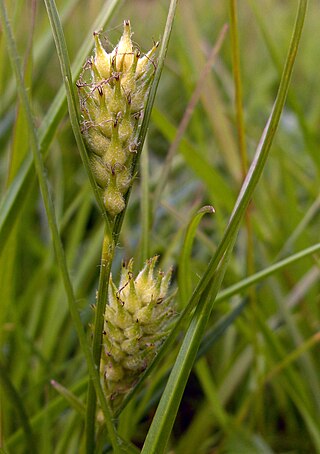
The Cyperaceae are a family of graminoid (grass-like), monocotyledonous flowering plants known as sedges. The family is large, with some 5,500 known species described in about 90 genera, the largest being the "true sedges" genus Carex with over 2,000 species.

Carpinus betulus, the European or common hornbeam, is a species of tree in the birch family Betulaceae, native to Western Asia and central, eastern, and southern Europe, including southern England. It requires a warm climate for good growth, and occurs only at elevations up to 1,000 metres (3,281 ft). It grows in mixed stands with oak, and in some areas beech, and is also a common tree in scree forests. Hornbeam was also known as yoke elm.

Ornamental grasses are grasses grown as ornamental plants. Ornamental grasses are popular in many colder hardiness zones for their resilience to cold temperatures and aesthetic value throughout fall and winter seasons.

Carex is a vast genus of nearly 2,000 species of grass-like plants in the family Cyperaceae, commonly known as sedges. Other members of the family Cyperaceae are also called sedges, however those of genus Carex may be called true sedges, and it is the most species-rich genus in the family. The study of Carex is known as caricology.
The putative Wych Elm cultivar Ulmus glabra 'Fastigiata Macrophylla' was first mentioned by Dieck in the Zöschen catalogue in 1885 as Ulmus montana forma fastigiata macrophylla, without description. Hartwig added a description in 1892. Berndt received "from a renowned nursery in Holstein" an Ulmus montana fastigiata macrophylla, possibly the same clone, in 1903, which he listed and described as Ulmus glabra fastigiata in Graf von Schwerin's Mitteilungen der Deutschen Dendrologischen Gesellschaft (1915).

Carex riparia, the greater pond sedge, is a species of sedge found across Europe and Asia. It grows in a variety of wet habitats, and can be a dominant species in some swamps. It is Britain's largest Carex, growing up to 130 cm tall, with glaucous leaves up to 160 cm long. It hybridises with a number of other Carex species, including the closely related Carex acutiformis – the lesser pond sedge. A variegated cultivar is grown as an ornamental grass.

Carex hirta, the hairy sedge or hammer sedge, is a species of sedge native across Europe. It has characteristic hairy leaves and inflorescences, and is the type species of the genus Carex.

Eusmilia is a genus of stony coral in the family Meandrinidae. It is a monotypic genus represented by the species Eusmilia fastigiata, commonly known as the smooth flower coral. It is found on reefs in the Caribbean Sea.

Grevillea fastigiata is a species of flowering plant in the family Proteaceae and is endemic to the south-west of Western Australia. It is an erect shrub with clustered branches, linear leaves sometimes with rigid lobes near the tip, and clusters of brownish or scarlet flowers.

Verticordia fastigiata, commonly known as mouse featherflower, is a flowering plant in the myrtle family, Myrtaceae and is endemic to the south-west of Western Australia. It is a prostrate or low shrub with small, club-shaped leaves and mouse-scented flowers which vary in colour from golden-yellow and orange to dark red.

Carex sect. Ovales is a section of the genus Carex, containing around 85 species of sedge. It is the most diverse section of the genus in North America, containing 72 species:

Carex subg. Carex is a subgenus of the sedge genus Carex. It is the largest of the four traditionally recognised subgenera, containing around 1400 of the 2000 species in the genus. Its members are characterised by the presence of one or more exclusively male (staminate) terminal spikes, quite dissimilar in appearance from the lateral female (pistillate) spikes below. In most species, the female flowers have three stigmas, but a few species, including Carex nigra, have female flowers with only two stigmas.

Carex subg. Vignea is a subgenus of the sedge genus Carex, containing around 300 of the 2000 species in the genus. Its members are characterised by having bisexual, sessile spikes, where the female flowers have two stigmas each.

The hybrid elm cultivar Ulmus × hollandica 'Fastigiata' was first listed and described as Ulmus glabra fastigiata, a narrow-crowned elm with large smooth leaves, by Petzold and Kirchner in Arboretum Muscaviense (1864). C. Berndt of the Berndt Nursery, Zirlau, Schweidnitz, described an elm of the same name in Mitteilungen der Deutschen Dendrologischen Gesellschaft, that he had received in 1903 "from a renowned nursery in Holstein" as Ulmus montana fastigiata macrophylla. A tree of that name had been listed by Dieck in 1885 without description. Berndt reported that his U. glabra fastigiata was "easy to confuse with U. montana superba", a tree "known in the Magdeburg region as Ulmus praestans", a statement confirming that, like that cultivar, his tree was a form of U. × hollandica. Karl Gustav Hartwig who received specimens of U. praestans from Kiessling of the Magdeburg city nursery in 1908, concluded (1912) that U. glabra fastigiataKirchner was indistinguishable in leaf or habit from U. praestans. An U. campestris glabra fastigiataArb. Musc. [ = Kirchner] was distributed by the Hesse Nursery, Weener, Germany, in the 1930s, where it was listed separately from U. praestans.

The elm cultivar Ulmus 'Fastigiata Glabra' was distributed by the Späth nursery, Berlin, in the 1890s and early 1900s as U. montana fastigiata glabra. Späth used U. montana both for cultivars of wych elm and for those of some U. × hollandica hybrids like 'Dampieri'. A specimen of U. montana fastigiata glabra in the Royal Botanic Garden Edinburgh was determined by Melville in 1958 as a hybrid of the U. × hollandica group.

Paronychia fastigiata, common names hairy forked chickweed, hairy forked nailwort, and forked chickweed, is an annual plant native to North America.

Chlorodesmis fastigiata is a species of algae belonging to the family Udoteaceae.














